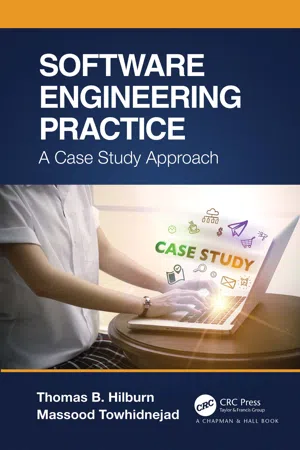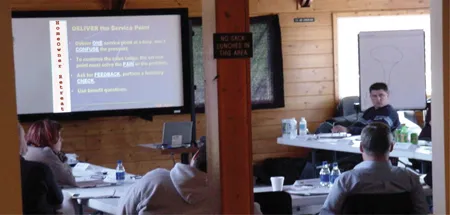
Software Engineering Practice
A Case Study Approach
- 340 pages
- English
- ePUB (mobile friendly)
- Available on iOS & Android
About This Book
This book is a broad discussion covering the entire software development lifecycle. It uses a comprehensive case study to address each topic and features the following:
- A description of the development, by the fictional company Homeowner, of the DigitalHome (DH) System, a system with "smart" devices for controlling home lighting, temperature, humidity, small appliance power, and security
- A set of scenarios that provide a realistic framework for use of the DH System material
- Just-in-time training: each chapter includes mini tutorials introducing various software engineering topics that are discussed in that chapter and used in the case study
- A set of case study exercises that provide an opportunity to engage students in software development practice, either individually or in a team environment.
Offering a new approach to learning about software engineering theory and practice, the text is specifically designed to:
- Support teaching software engineering, using a comprehensive case study covering the complete software development lifecycle
- Offer opportunities for students to actively learn about and engage in software engineering practice
- Provide a realistic environment to study a wide array of software engineering topics including agile development
Software Engineering Practice: A Case Study Approach supports a student-centered, "active" learning style of teaching. The DH case study exercises provide a variety of opportunities for students to engage in realistic activities related to the theory and practice of software engineering. The text uses a fictitious team of software engineers to portray the nature of software engineering and to depict what actual engineers do when practicing software engineering. All the DH case study exercises can be used as team or group exercises in collaborative learning. Many of the exercises have specific goals related to team building and teaming skills.
The text also can be used to support the professional development or certification of practicing software engineers. The case study exercises can be integrated with presentations in a workshop or short course for professionals.
Frequently asked questions
Information
Chapter 1
Birth of DigitalHome


- ■ Establish a new DigitalHomeOwner Division of HomeOwner to be headed by Jose Ortiz (currently Deputy CIO).
- ■ Develop a two-year strategic plan for the division.
- ■ Assemble a staff for the division.
- ■ Develop a one-year division budget plan.
- ■ With the assistance of the Marketing Division, DigitalHomeOwner will research the existing smart houses, and conduct a needs assessment for a DigitalHome product, which will provide the computer and communication infrastructure for managing and controlling the “smart” devices in a home to best meet the needs and desires of homeowners. In other words, building houses that take the advantage of Internet of Things (IoT) technology.
- ■ Choose a set of features for the DigitalHome product to develop a high-quality “proof of concept” prototype to illustrate how the DigitalHome needs will be met. Because of time constraints, the features chosen will be a subset of the actual needs. It is envisioned that this will primarily be a “software effort”, with simulation being used to represent dwelling structures, hardware devices, and communication links.
- ■ Jose Ortiz will form a team and supervise it in the development of the DigitalHome prototype.
- ■ Jose Ortiz will deliver a report on the DigitalHome efforts at the August 202Y strategic planning retreat.
- ■ In addition, DigitalHome will include the following special considerations:
- – It is anticipated that the DigitalHome prototype will be the foundation for future development of DigitalHomeOwner products. Hence, it is essential that the development team use established software engineering practices and fully document their work.
- – In development of the prototype, DigitalHomeOwner should have two primary client groups: (1) potential DigitalHome users and (2) the upper management of HomeOwner. These clients should be part of an acceptance testing process for the prototype.
- – At the retreat, Judy Fielder, the CIO, also presented a proposal (HomeOwner Cloud Computing Initiative Proposal) for development of a HomeOwner cloud server. Although the decision on the cloud initiative was tabled for further study, it was recommended that the DigitalHome developers consult the guidance provided in the proposal, especially as related to the privacy and security of client communication and data.
Software Engineering Problems
The Nature of Software
- ■ Complexity – Brooks argues that software entities are more complex, for their size, than perhaps any other human construct. Even moderately complex software systems may have millions of distinct parts (components/packages, classes/objects, variables, methods, and statements), which may be stored in an extremely small physical ...
Table of contents
- Cover
- Half Title
- Title Page
- Copyright Page
- Table of Contents
- Preface
- Acknowledgments
- Authors
- 1 In The Beginning
- 2 Launching DigitalHome
- 3 Assuring DigitalHome Quality
- 4 Managing the DH Project
- 5 Engineering the DH Requirements
- 6 Designing DigitalHome
- 7 Constructing DigitalHome
- 8 Maintaining DigitalHome
- 9 Acting Ethically and Professionally
- 10 Using the Scrum Development Process
- References
- Appendix A: Digital Home Customer Need Statement
- Appendix B: DigitalHome Software Requirements Specification
- Appendix C: DigitalHome Use Case Model
- Index